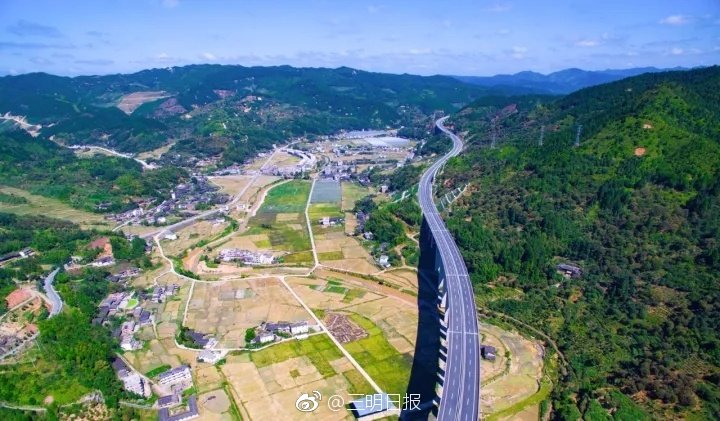Rural revitalization in remoter regions of China has long been impeded by backward logistics, creating a rising demand for solutions.

Aerial photo taken on November 16, 2017 shows a highway linking Xiamen, capital of Fujian Province, and Shaxian County in Fujian.
With this in mind, a state-level demonstration county for rural e-commerce was set up in Shaxian County in China's southeastern Fujian Province.
An innovative model for a countywide logistics center has helped reinvigorate the postal network and ensure first-mile and last-mile deliveries.
Unavailable routes
"The first-mile delivery from villages to larger townships was not accessible as there were no collection points in villages," said Zhan Xianhui, the Communist Party of China (CPC) secretary of Nanyang Township, Shaxian County.
For that simple reason, agricultural products could not sell for a good price, Zhan noted.
Logistics companies, county businesses and companies were all unwilling to take the plunge and subsidize the construction of convenient delivery points in townships for the betterment of their own long-term interests.
Despite the obvious demand for agricultural produce from villages, logistics contractors saw that it would take time to cultivate such a market.
"The imperfection of the logistics network at the village level is one of the biggest difficulties for e-commerce to enter villages," said Ye Wenzhong, director of the Shaxian County commerce bureau.
Charges at delivery points were also high. One villager said he had to pay an additional 2-10 yuan to pick up a package.
Three-tier solution
To address these issues in December 2017, the Shaxian branch of China Post developed a three-tier logistics network: counties to townships to villages.
First, a comprehensive rural e-commerce logistics center was established in Shaxian County offering storage, collection, sending, sorting and delivery functions.
Second, 10 logistics stations were set up in townships based on the already existing postal offices.
Third, delivery points were made accessible in 120 densely populated villages.
Following the three-tier innovation, villagers' expenditure on package reception fell 30 percent within a year, according to Huang Hanrong, general manager of China Post Sanming branch.
The innovation also offered agricultural products more timely out channels, leading to a rise in both sales and sales prices.
Outside delivery costs had been reduced by 40 percent, said Yang Haodong, a villager who sells a local specialty.
Officials statistics show that compared with a year before, the number of packages delivered to and from Shaxian increased by more than 1 million, or more than 50 percent, in 2019.
Unsolved bottlenecks
The network has enhanced efficiency of the postal network, lowered the delivery costs of private companies and provided a model available to be replicated nationwide.
To set up such a three-tier logistics system from scratch, a company would have to invest nearly 6 million yuan (US$866,350) in hardware facilities, said Liu Xin, general manager of China Post Shaxian branch.
But China Post spent about 2 million yuan (US$288,783), largely reducing the initial investment by building atop its original network.
When completed, the platform will be shared with partner companies to avoid repeat construction costs and waste of resources, Liu said.
Unshared data among companies is also detrimental to integration of resources, which will waste human resources and reduce work efficiency.
The operating cost of the logistics, not covered by current subsidies, is higher than the investment in hardware facilities.
"The first three years after construction will be hardest. The annual operating cost will be as high as 5-6 million yuan (US$721,959-US$866,350)," Liu said.
"It remains a thought-provoking problem how to adjust policies to conform to the situation of rural logistics operation and encourage more companies to join in construction."
(Translated by Lyu Fu and edited by Liu Xiaochi; Original story from Banyuetan)


